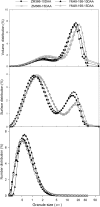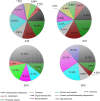Quantitative analysis of the grain amyloplast proteome reveals differences in metabolism between two wheat cultivars at two stages of grain development
- PMID: 30355308
- PMCID: PMC6201562
- DOI: 10.1186/s12864-018-5174-z
Quantitative analysis of the grain amyloplast proteome reveals differences in metabolism between two wheat cultivars at two stages of grain development
Abstract
Background: Wheat (Triticum aestivum L.) is one of the world's most important grain crops. The amyloplast, a specialized organelle, is the major site for starch synthesis and storage in wheat grain. Understanding the metabolism in amyloplast during grain development in wheat cultivars with different quality traits will provide useful information for potential yield and quality improvement.
Results: Two wheat cultivars, ZM366 and YM49-198 that differ in kernel hardness and starch characteristics, were used to examine the metabolic changes in amyloplasts at 10 and 15 days after anthesis (DAA) using label-free-based proteome analysis. We identified 523 differentially expressed proteins (DEPs) between 10 DAA and 15 DAA, and 229 DEPs between ZM366 and YM49-198. These DEPs mainly participate in eight biochemical processes: carbohydrate metabolism, nitrogen metabolism, stress/defense, transport, energetics-related, signal transduction, protein synthesis/assembly/degradation, and nucleic acid-related processes. Among these proteins, the DEPs showing higher expression levels at 10 DAA are mainly involved in carbohydrate metabolism, stress/defense, and nucleic acid related processes, whereas DEPs with higher expression levels at 15 DAA are mainly carbohydrate metabolism, energetics-related, and transport-related proteins. Among the DEPs between the two cultivars, ZM366 had more up-regulated proteins than YM49-198, and these are mainly involved in carbohydrate metabolism, nucleic acid-related processes, and transport.
Conclusions: The results of our study indicate that wheat grain amyloplast has the broad metabolic capability. The DEPs involved in carbohydrate metabolism, nucleic acids, stress/defense, and transport processes, with grain development and cultivar differences, are possibly responsible for different grain characteristics, especially with respect to yield and quality-related traits.
Keywords: Amyloplast; Grain development; Proteome; Starch characteristics; Wheat.
Conflict of interest statement
Ethics approval and consent to participate
Not applicable. The wheat cultivar Zhengmai366 seeds used in this study were produced by Henan Academy of Agricultural Science. The seeds of Yumai49–198 in this study were produced by Pingan Seeds Company. The two cultivars,Zhengmai366 and Yumai49–198, have been approved by the Henan Crop Variety Appraisal Committee (Number: 2005003, and 2,005,006, respectively), and widely cultivated in the Yellow and Huai River Valleys Winter Wheat Zone of China. A voucher specimen of this material has not been deposited in a publicly available herbarium. We stated that field studies was conducted in accordance with local legislation and complied with the Convention on the Trade in Endangered Species of Wild Fauna and Flora.
Consent for publication
Not applicable
Competing interests
The authors declare that they have no competing interests.
Publisher’s Note
Springer Nature remains neutral with regard to jurisdictional claims in published maps and institutional affiliations.
Figures







Similar articles
-
iTRAQ-based quantitative proteome and phosphoprotein characterization reveals the central metabolism changes involved in wheat grain development.BMC Genomics. 2014 Nov 27;15(1):1029. doi: 10.1186/1471-2164-15-1029. BMC Genomics. 2014. PMID: 25427527 Free PMC article.
-
Distinct metabolic changes between wheat embryo and endosperm during grain development revealed by 2D-DIGE-based integrative proteome analysis.Proteomics. 2016 May;16(10):1515-36. doi: 10.1002/pmic.201500371. Epub 2016 Apr 27. Proteomics. 2016. PMID: 26968330
-
Differential representation of albumins and globulins during grain development in durum wheat and its possible functional consequences.J Proteomics. 2017 Jun 6;162:86-98. doi: 10.1016/j.jprot.2017.05.004. Epub 2017 May 3. J Proteomics. 2017. PMID: 28478307
-
Physiology and Molecular Breeding in Sustaining Wheat Grain Setting and Quality under Spring Cold Stress.Int J Mol Sci. 2022 Nov 15;23(22):14099. doi: 10.3390/ijms232214099. Int J Mol Sci. 2022. PMID: 36430598 Free PMC article. Review.
-
An Overview of Factors Affecting the Functional Quality of Common Wheat (Triticum aestivum L.).Int J Mol Sci. 2023 Apr 19;24(8):7524. doi: 10.3390/ijms24087524. Int J Mol Sci. 2023. PMID: 37108683 Free PMC article. Review.
Cited by
-
Genome Wide Identification and Comparative Analysis of the Serpin Gene Family in Brachypodium and Barley.Plants (Basel). 2020 Oct 26;9(11):1439. doi: 10.3390/plants9111439. Plants (Basel). 2020. PMID: 33114466 Free PMC article.
-
"Omics" insights into plastid behavior toward improved carotenoid accumulation.Front Plant Sci. 2022 Oct 6;13:1001756. doi: 10.3389/fpls.2022.1001756. eCollection 2022. Front Plant Sci. 2022. PMID: 36275568 Free PMC article. Review.
-
Deciphering heat wave effects on wheat grain: focusing on the starch fraction.Front Plant Sci. 2024 Dec 4;15:1459283. doi: 10.3389/fpls.2024.1459283. eCollection 2024. Front Plant Sci. 2024. PMID: 39711586 Free PMC article.
-
Preferentially expressed endosperm genes reveal unique activities in wheat endosperm during grain filling.BMC Genomics. 2024 Aug 22;25(1):795. doi: 10.1186/s12864-024-10713-4. BMC Genomics. 2024. PMID: 39174916 Free PMC article.
-
Transcriptomic and proteomic analysis reveals mechanisms of low pollen-pistil compatibility during water lily cross breeding.BMC Plant Biol. 2019 Dec 5;19(1):542. doi: 10.1186/s12870-019-2166-3. BMC Plant Biol. 2019. PMID: 31805858 Free PMC article.
References
-
- Evers AD, Gough BM, Pybus JN. Scanning electron microscopy of wheat starch. IV. Digestion of large granules by glucoamylase of fungal (Aspergillus niger) origin. Starch/Stärke. 1971;23:16–18. doi: 10.1002/star.19710230106. - DOI
MeSH terms
Substances
Grants and funding
LinkOut - more resources
Full Text Sources

